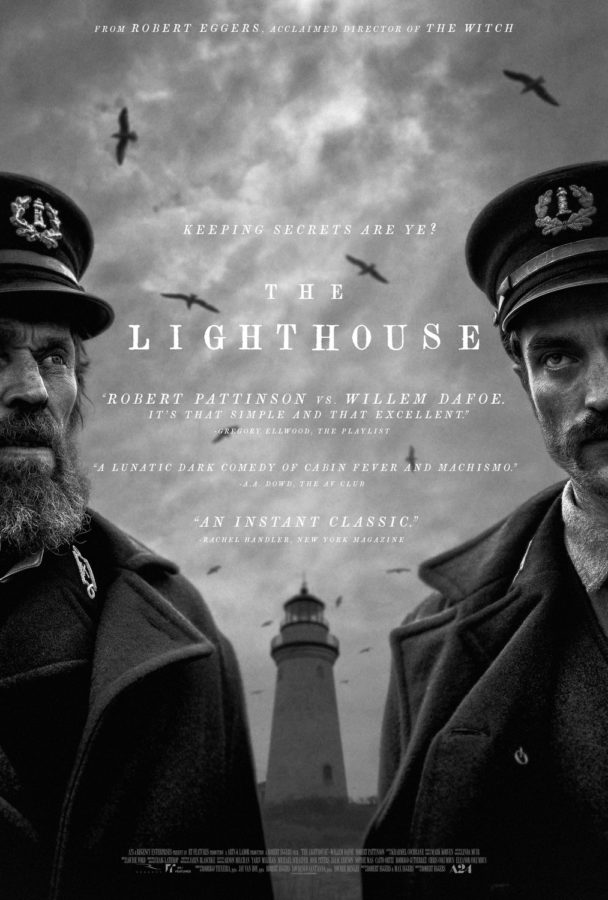Frequent Film Fanatic Findings: ‘The Lighthouse’
Welcome to a mediocre film lover’s review of past and present movies, with no formal credentials but a handful of film classes.
I start this column by choosing a movie that stars two lead actors who have regained attention in Hollywood headlines and analyze “The Lighthouse”, starring Willem Dafoe, who recently hosted Saturday Night Live, and Robert Pattinson, who will soon be seen again on the silver screen in a three-hour Batman film. Opinions of those noted performances aside, the two delve deep into the lore of old-timey New England shoremen around the 1890s who are slowly losing their marbles, if their characters even had any marbles to begin with.
The film is edited in a grainy black and white color grading, with a nearly square ratio, allowing the audience to feel as if it is looking through an antique viewfinder. Director Robert Eggers commented many times that this look gives a discernable aged feel to the film. In the sound editing department, every hum or droning sound was methodical in lulling the audience into madness for nearly two hours. The noises came at seemingly random points in a scene.
Upon first introduction, Dafoe and Pattinson stand squarely in front of the camera, breaking the fourth wall (an imaginary wall at the opening of a film that keeps performers from recognizing or directly addressing their audience) with.their lifeless stares into the camera. A young man named Thomas, who started his job as a second keeper at the lighthouse, leans on the left and his superior, the much older shoreman also named Thomas, is close behind him on the right.
About halfway through the movie, young Thomas demands Thomas stop treating him like a child when he gets called “lad” instead of his real name. Thomas continues to belittle him any way he can, first calling him Tommy, as well as giving him the short end of the stick by ordering him to do laborious chores. Meanwhile, the old drunken bag of wind that is Thomas would go on muttering and mumbling his poetic ramblings, which to an average film viewer don’t make any logical sense. Perhaps that was the point all along – to make as little sense as humanly possible while still maintaining the smallest bit of a plot so there would be some definitive progression in the film.
“The Lighthouse” is structured in an unorthodox way. At first glance, there is no traditional exposition, rising action, or denouement, so if you like watching a story unfold with a neat little bow tying everything up at the end, save yourself two hours and don’t watch this one.
It felt fairly dense to get through, so I broke it up into two parts for watching. With days in between both parts, I didn’t feel like I lost even the slightest bit of what little understanding I had going on throughout most of the film. That does not lend itself to mean I didn’t thoroughly enjoy watching this movie. Overall, in the beginning, the film offered a good background into what the life of a working shoreman could possibly look like, but that quickly disappeared as the characters went crazy.
I enjoyed the shot composition throughout the film, such as when the audience could see a clear divide between the two men’s beds showcasing their separate roles, the small door frame that highlighted Tommy’s encroaching chores bearing down on him, and the dizzying spiral staircase that led to the sequestered light at the top. There were a handful of well-placed sweeping landscape shots that established a clear setting and mood in the scene, depending on what weather the characters faced.
An unnamed source who cared to share thoughts of the film summed it up best. The source said, “How do you tell viewers that under no circumstances should you ever watch this with any member of your family”? Heed the mysterious viewer’s warning and avoid eating while watching the movie, as well.
Although the film is not inherently graphic or gory, there were several times I visibly cringed. After watching two men working together and getting drunk together for so long, they’re bound to think and do questionable things. This unfortunately included “habitual self abuse in the supply shed” as Dafoe’s character Thomas writes in his logbook while he oversees Tommy’s work ethic during his contract at the lighthouse.
I leave it up to the viewer to form an own opinion of this movie. Lesson certainly learned: don’t disrespect your elder’s cooking and don’t get trapped in a lighthouse on the coast of somewhere in New England with Willem Dafoe. If you do, it’s time for “Lights Out”!

